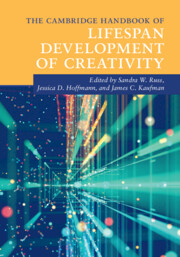Book contents
- The Cambridge Handbook of Lifespan Development of Creativity
- The Cambridge Handbook of Lifespan Development of Creativity
- Copyright page
- Dedication
- Contents
- Figures
- Tables
- Contributors
- Acknowledgments
- Introduction
- Part I Core Concepts of Lifespan Creativity Development
- Part II The Development of Creativity
- Part III Modes of Enhancement
- Part IV Environments and Contexts
- Part V Special Populations
- 23 The Development of Gifted and Talented Students’ Creativity in School Contexts
- 24 Creative Play in Children with Neurodevelopmental Disorders
- 25 Eminent Creators
- Epilogue: What Have We Learned?
- Index
- References
24 - Creative Play in Children with Neurodevelopmental Disorders
Assessment, Intervention, and Future Directions
from Part V - Special Populations
Published online by Cambridge University Press: 19 November 2021
- The Cambridge Handbook of Lifespan Development of Creativity
- The Cambridge Handbook of Lifespan Development of Creativity
- Copyright page
- Dedication
- Contents
- Figures
- Tables
- Contributors
- Acknowledgments
- Introduction
- Part I Core Concepts of Lifespan Creativity Development
- Part II The Development of Creativity
- Part III Modes of Enhancement
- Part IV Environments and Contexts
- Part V Special Populations
- 23 The Development of Gifted and Talented Students’ Creativity in School Contexts
- 24 Creative Play in Children with Neurodevelopmental Disorders
- 25 Eminent Creators
- Epilogue: What Have We Learned?
- Index
- References
Summary
It is widely known that pretend play and creativity are essential developmental processes for typically developing children, but there has been little collective examination of the role of creative play in children with developmental disabilities. In this chapter, we review the importance of creativity for children with various developmental disabilities, with a specific focus on pretend play. Research over the past decade in disorders such as autism spectrum disorder (ASD), Down Syndrome (DS), cerebral palsy (CP), Prader-Willi Syndrome (PWS), and Williams Syndrome (WS) indicates that pretend play is a development skill area where many of these children show deficits, and these deficits may be impactful on their ability to develop appropriate social, emotional, cognitive, and behavioral skills associated with pretend play. Recent research also suggests that pretend play can be used as a means of intervention to improve the play skills and associated skills of socioemotional and cognitive-behavioral functioning in children with developmental disabilities. Future study should examine the use of increasingly accessible means of pretend play intervention, such as telehealth, and focus on how parent-training interventions can be utilized to effectively implement pretend play for children with developmental disabilities at an early age.
Keywords
- Type
- Chapter
- Information
- The Cambridge Handbook of Lifespan Development of Creativity , pp. 512 - 529Publisher: Cambridge University PressPrint publication year: 2021



